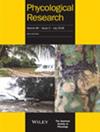Kuwaitiella rubra gen. et sp. nov. (Bangiales, Rhodophyta), a new filamentous genus and species from the north‐western Indian Ocean
IF 1
4区 生物学
Q2 MARINE & FRESHWATER BIOLOGY
引用次数: 3
Abstract
A new filamentous marine red alga, Kuwaitiella rubra gen. et sp. nov. (Bangiales, Rhodophyta), is described from Kuwait in the north‐western Arabian Gulf (also referred to as the Persian Gulf). It was found on a submerged fishing line. The intensively red upright thallus of up to 1 cm in length consists of cells containing a single stellate plastid. The thallus is initially uniseriate but becomes biseriate in its distal part upon transformation into globular reproductive cells, possibly archaeospores. The biseriate fertile part is the only morphological difference from other filamentous species of the Bangiales, in which this region is parenchymatous. In culture, bipolar asymmetric germination of the spores of Kuwaitiella led to a new generation of identical erect thalli, fixed to the substratum by colourless rhizoids. According to phylogenetic analyses of partial small subunit nuclear ribosomal DNA (18S) and of the plastid‐encoded ribulose‐1,5‐bisphosphate carboxylase/oxygenase large subunit (rbcL), the new species forms an additional lineage of the Bangiales, genetic similarity with other taxa being limited (maximum 91% in SSU and 90% in rbcL). It was no clear member of any known lineage of the Bangiales but was weakly associated with the filamentous species Minerva and Dione from New Zealand. In a SSU phylogeny, it formed a basal branch in the Bangiales and clustered with M. aenigmata and D. arcuata as sister clade to all other species of the order. In a rbcL phylogeny, it was part of a large polytomy of lineages, its closest relative being D. arcuata. Kuwaitiella forms the 8th lineage of filamentous Bangiales detected so far.Kuwaitiella rubra gen.et sp.nov.(Bangiales,Rhodophyta),印度洋西北部一个新的丝状属和种
一种新的丝状海洋红藻Kuwaitiella rubra gen.et sp.nov.(Bangiales,Rhodophyta)来自阿拉伯湾西北部的科威特(也称为波斯湾)。它是在一条被淹没的钓鱼线上发现的。高达1厘米长的强烈红色直立铊由含有单个星状质体的细胞组成。铊最初是单列的,但在转化为球状生殖细胞(可能是古孢子)后,其远端变成双列。双列可育部分是Bangiales的其他丝状物种唯一的形态差异,在Bangialees中,该区域是实质性的。在培养中,Kuwaitiella孢子的双极不对称萌发导致了新一代相同的直立铊,通过无色的根瘤固定在基质上。根据部分小亚基核核糖体DNA(18S)和质体编码的核酮糖-1,5-二磷酸羧化酶/加氧酶大亚基(rbcL)的系统发育分析,新物种形成了Bangiales的一个额外谱系,与其他分类群的遗传相似性有限(SSU中最大为91%,rbcL中最大为90%)。它不是Bangiales任何已知谱系的明确成员,但与来自新西兰的丝状物种Minerva和Dione弱相关。在SSU系统发育中,它在Bangiales中形成了一个基部分支,并与M.aenigmata和D.arcuata聚为该目所有其他物种的姐妹分支。在rbcL的系统发育中,它是一个大型多谱系的一部分,它的近亲是D.arcuata。Kuwaitiella是迄今为止发现的第8个丝状Bangiales谱系。
本文章由计算机程序翻译,如有差异,请以英文原文为准。
求助全文
约1分钟内获得全文
求助全文
来源期刊

Phycological Research
生物-海洋与淡水生物学
CiteScore
3.60
自引率
13.30%
发文量
33
审稿时长
>12 weeks
期刊介绍:
Phycological Research is published by the Japanese Society of Phycology and complements the Japanese Journal of Phycology. The Journal publishes international, basic or applied, peer-reviewed research dealing with all aspects of phycology including ecology, taxonomy and phylogeny, evolution, genetics, molecular biology, biochemistry, cell biology, morphology, physiology, new techniques to facilitate the international exchange of results. All articles are peer-reviewed by at least two researchers expert in the filed of the submitted paper. Phycological Research has been credited by the International Association for Plant Taxonomy for the purpose of registration of new non-vascular plant names (including fossils).
 求助内容:
求助内容: 应助结果提醒方式:
应助结果提醒方式:


